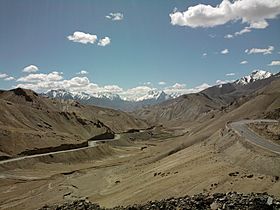Fatu La Pass facts for kids
Quick facts for kids Fotu La |
|
|---|---|
| फ़ोतु ला | |

Fotu La
|
|
| Elevation | 4,108 m (13,478 ft) |
| Traversed by | Srinagar-Leh highway |
| Location | India |
| Range | Himalaya, Zaskar Range |
| Coordinates | 34°17′38″N 76°42′08″E / 34.29389°N 76.70222°E |
Fotu La (also called Fatu La) is a very high mountain pass. It is found on the famous Srinagar-Leh highway. This pass is in the amazing Himalaya mountains. It is located in the region of Kashmir, India.
Contents
Fotu La: A High Mountain Pass
Fotu La is known as the highest point on the Srinagar-Leh highway. This road connects the cities of Srinagar and Leh. A mountain pass is like a natural gateway through mountains. It makes it easier to travel from one side of a mountain range to another. Without passes, crossing huge mountains would be much harder.
Where is Fotu La Located?
Fotu La is in the northern part of India. It is part of the mighty Himalaya mountain range. Specifically, it's in the Zanskar Range, which is a part of the Himalayas. The pass is at a very high elevation. It sits at about 4,108 meters (13,478 feet) above sea level. This makes it one of the highest points you can reach by road.
The Srinagar-Leh Highway
The highway that goes over Fotu La is very important. It's called National Highway 1D. This road is a lifeline for many communities. It connects the Kashmir Valley with the Ladakh region. People use it to transport goods and for tourism. The journey through the pass offers stunning views. You can see snow-capped peaks and deep valleys.
Challenges of the Pass
Because Fotu La is so high, the weather can be very harsh. It gets extremely cold, and there is a lot of snow. This means the pass is often closed during winter months. It usually opens only from late spring to autumn. Engineers and road workers work hard to keep it clear. They make sure people can travel safely when it's open.
Why is Fotu La Important?
Fotu La has been important for a long time. It has helped people travel and trade between different regions. In the past, it was part of old trade routes. Today, it still plays a key role in connecting remote areas. It helps people access supplies and services. It also allows tourists to explore the beautiful landscapes of Ladakh. Many adventurers and travelers visit this pass. They want to experience its height and beauty.

